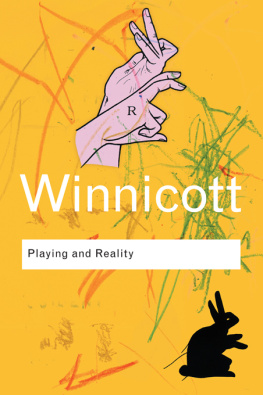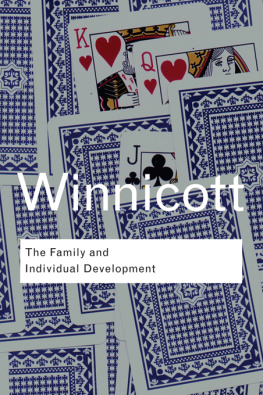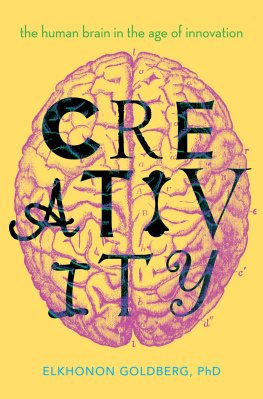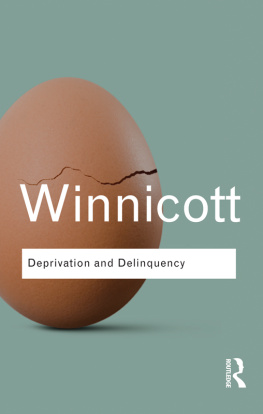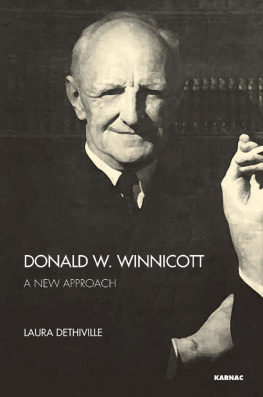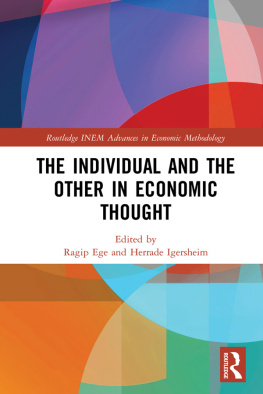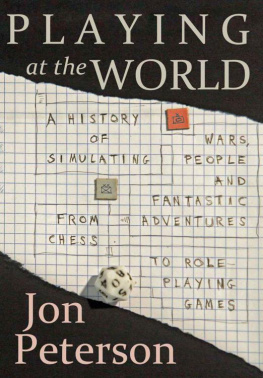
Playing and Reality
Winnicott was the greatest British psychoanalyst who ever lived. He writes beautifully and simply about the problems of everyday life and is the perfect thing to read if you want to understand yourself and other people better.
Alain de Botton
He was a man who could be popular and completely accessible without ever ceasing to be profound, a man who ranged audaciously far and wide in the realms of thought but who always came back to home base, the psychology of the child.
Oliver Sacks, The New York Times Book Review

Routledge classics contains the very best of Routledge publishing over the past century or so, books that have by popular consent, become establish as classics in their field. Drawing on a fantastic heritage of innovative writing published by Routledge and its associated imprints, this series makes available in attractive, affordable form some of the most important works modern times.
For a complete list of titles visit
www.routledgeclassics.com
D. W.
Winnicott
Playing and Reality
With a new preface by F. Robert Rodman, North Carolina State University

First published 1971
by Tavistock Publications Ltd
First published in the USA in paperback in 1982
First published by Routledge in paperback in Great Britain in 1991
First published in Routledge Classics 2005
by Routledge
2 Park Square, Milton Park, Abingdon, Oxon, OX14 4RN
Simultaneously published in the USA and Canada
by Routledge
711 Third Avenue, New York, NY 10017 8th (Floor)
Routledge is an imprint of the Taylor & Francis Group, an informa business
1971 D. W. Winnicott
2005 Preface to the Routledge Classics edition, F. Robert Rodman
Typeset in Joanna by RefineCatch Limited, Bungay, Suffolk
All rights reserved. No part of this book may be reprinted or reproduced or utilised in any form or by any electronic, mechanical, or other means, now known or hereafter invented, including photocopying and recording, or in any information storage or retrieval system, without permission in writing from the publishers.
British Library Cataloguing in Publication Data
A catalogue record for this book is available from the British Library
Library of Congress Cataloging in Publication Data
A catalog record for this book is available from the Library of Congress
ISBN10: 0415345464
ISBN13 : 9780415345460
To my patients who have paid to teach me
CONTENTS
ACKNOWLEDGEMENTS
I wish to thank Mrs Joyce Coles for her help in the preparation of the manuscript.
Also, I am much indebted to Masud Khan for his constructive criticisms of my writings and for his always being (as it seems to me) available when a practical suggestion is needed.
I have expressed my gratitude to my patients in my dedication.
For permission to reproduce material that has already appeared in print, thanks are due to the following: the Editor of Child Psychology and Psychiatry; the Editor of Forum; the Editor of the International Journal of Psycho-Analysis; the Editor of Pediatrics; the Editor of the International Library of Psycho-Analysis; Dr Peter Lomas; and the Hogarth Press Ltd, London.
PREFACE TO THE ROUTLEDGE CLASSICS EDITION
This collection of essays, prepared just before Winnicotts death in 1971, has been read and reread with profit by those interested in the ideas for their own sake, as well as all those who are trying to understand human beings in order to help them. In addition to a running description of his theory, Winnicott typically tells us over and over again what he means to get across. Each repetition adds some new element, as if in rehearsing these ideas he surprises himself with something new at the end of the trajectory of thought he has built up to that point. We, his readers, are the benefactors, because we get one chance after another to follow his development and to grasp the great arc of understanding that he brought to human development.
The paper on transitional objects (1953) starts the progression. It represents the summary achievement to that point of many preceding papers. The focus lies between baby and mother in the form of an object that is both created and discovered, which is the characteristic that yields freedom and joy to babies and all who were once babies. The mother provides what the baby is ready to imagine and in so doing she facilitates the babys pleasure in a world that fosters its sense of omnipotence. The simple recognition of the meaning of soft toys and bits of blankets to babies, an understanding which, as Anna Freud put it, conquered the psychoanalytic world, came into our grasp easily and obviously once Winnicott has explained it to us, although it had been overlooked by all until this point. Probably it took not only a child analyst but a pediatrician as well to perceive the significance of these materials. Winnicott started out and remained a pediatrician throughout his career. He estimated that in that time he had consulted with about 60,000 mother/child pairs.
He understood that the transition from having all its needs automatically met, in utero, to a capacity to accept the otherness of the external world, the child would have to develop over a long period of time during which the early sense of omnipotence was gradully succeeded by manageable frustrations. The same mother who provided the object that was made transitional is the mother that fails to meet the babys needs according to its ability to grow as a result of the graduated failures.
With his theory of the transitional object, Winnicott jolted all ponderers on human nature into a realization of the neverending oscillation between the inner and the outer worlds. By implication, a state of dependency emerges as continuous in human life, and the environment therefore also as continuously important. Psychoanalysis, in the form of Freuds original and later theories, and Kleins especially had failed to appreciate this crucial fact. With Winnicott, we could take account of the role of the environment without at the same time losing the distinctly psychoanalytic awareness of the role of the inner life. And Winnicotts affirmation of Freuds work placed him in a continuous line of development in psychoanalysis, rather than play the role of a dissident. In spite of many opportunities to become the leader of the so-called object relations school, Winnicott declined, and turned away from any hint of discipleship among those who were influenced by him. He always believed that individual analysts had to find their own way, in effect to rediscover for themselves what others had found in their own way. This makes his work immensely appealing to younger therapists seeking a path that can make the most of their individual histories, talents and interests.
From transitional objects, through various papers on play and creativity, through considerations of culture as a development from transitional space, we get to the revolutionary ideas in his late paper on The Use of an Object. Here Winnicott gives us a new awareness of personal factors in the creation of reality. He focuses on relationships that become of use. Especially important individuals survive the continuous backdrop of unconscious destructive fantasy that inevitably accompanies closeness. That other person, by surviving the hate that emerges as a response to his or her otherness, attains a special status as a contributor to life, one who nourishes with what is genuinely new. This paper, coming near the end of Winnicotts life, opens pathways of thought for those who follow. Can it be true that all we perceive, the world out there, in the form of relationships as well as sensory perceptions, is observable insofar as it survives continuous fantasies of destruction? Can it be that we can tell that something is really out there only if it continues to be there in spite of destructive processes emanating from ourselves? Recent work on the visual faculty seems to support the notion that the seen world is a constructed world, not a passively perceived one. Winnicotts theory, generated entirely from his own long study of human interaction, with its emphasis on a dynamic process of perception rooted in conflict, would seem to form a link between psychoanalysis and neurophysiology.
Next page
